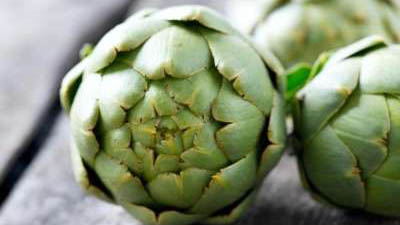How to Grow Artichoke in Your Garden

Artichoke prefers a sunny location and fertile, well drained soils. Incorporate plenty of organic matter into the area before planting. Start plants in late winter for early spring planting. Plant artichoke 18 inches apart in rows 2-3 feet wide. Fertilize the plants regularly with nitrogen and keep the soil moist throughout the summer. Control all pests that reduce vigor during the year. Harvest artichoke buds when they reach full size but before the bracts open. Plants are frost and freeze sensitive so they need to be protected if they are to over-winter outdoors. Imperial Star and Green Globe varieties perform well in Utah.
Recommended Artichoke Varieties
| Variety | Yield | Comments |
|---|---|---|
| Imperial Star | Excellent | Medium sized plants, many dark green buds with small hearts, good disease resistance, excellent as an annual crop. |
| Green Globe | Excellent | Large sized plants, many dark green buds with large hearts, do best if plants are maintained for several years. |
How to Grow Artichokes
Soils

Artichoke prefers organic, rich, fertile soils for best growth. Most soils are acceptable provided they are well drained.
Plants
Purchase quality plants from local garden centers or seed catalogs if available. You may also grow artichoke transplants from seed. Germinate seeds at 70-75F, then plant in 2-3 inch pots. Start seeds in early January. Plants require 2-3 months to reach transplantable size.
Planting and Spacing
Artichoke should be planted 3-4 weeks before the frost-free date for your area. Artichoke requires cool spring temperatures to initiate the flower stalk. If planted too late, plants do not get the required chilling, therefore, plants will not flower. Space plants 18 inches apart in the row, with rows 2-3 feet apart. Planting through plastic mulches accelerates early growth and leads to higher yields. Water frequently after transplanting to ensure good root and shoot growth. Maintain healthy vigorous growth during the spring and summer to ensure that artichoke produces for a long time.
Water
Water frequently during the year by supplying 1 to 2 inches per week in several applications. Use drip irrigation if possible. Mulch heavily around the plants with an organic mulch like compost, grass clippings, or straw to conserve soil moisture and reduce weed growth. Mulches help keep the soil cool. Artichoke has a shallow root system, does not tolerate hot, dry conditions and likes moist soils if high productivity is expected.
Fertilization
Artichoke requires high amounts of nitrogen fertilizer for best growth and development. Apply 2 teaspoons per plant of a nitrogen-based fertilizer (21-0-0) every 4 weeks beginning 4 weeks after transplanting to encourage sustained and rapid plant growth. Place the fertilizer to the side of the plant and irrigate it into the soil.
Common Problems with Growing Artichokes
Weeds
Control weeds in artichoke. Mulch artichoke heavily (2-3 inches) with compost or other organic mulches to keep weeds down and hold retain soil moisture. Till carefully around artichoke. Roots are shallow and damage to the roots slows growth.
| Pests | Description and Symptoms | Control |
|---|---|---|
| Aphids | Green sucking insects that stunt leaves and reduce yield and plant vigor. Aphids damage young plants the most. | Use insecticidal soaps, strong water stream to dislodge the insect, or labeled insecticides. |
| Diseases | Symptoms | Control |
|---|---|---|
| Root Rot Diseases | Fungal diseases reduce plant vigor. Leaf tips turn yellow, new growth stops, and plants eventually dies. Buds are small and tough. | Reduce plant stresses including insects, over watering, over cutting, drought, and weed pressure. |
| Viruses | Virus cause plants to decline and die and yields to go down. | Control aphids that transmit the disease. |
How to Harvest and Store Artichokes
Harvesting
Artichoke harvest begins in late July or early August and continues until frost. Once the flower buds form, do not water stress the plant. Harvest buds when they reach full size but before the bracts (bud leaves) begin to open. Cut off the bud with 2-3 inches of stem. Continue to water and feed the plants. Buds not harvested produce attractive purple blooms that can be used as centerpieces or dried and used in flower arrangements.
Fall Plant Care
After harvest is completed and the plant has received several frosts, cut back the leaves and mulch the root heavily. Throw 4-6 inches of soil over the plants, then cover with 8-12 inches of leaves or straw. Heavy mulching may allow the plant to over-winter in the garden in milder winter areas of Utah. In the colder areas of the state, dig up the plants and store them in a cold cellar in moist sand or peat to keep the plant from drying out. Divide and replant the root pieces the following spring.
Productivity
Each flower stalk will produce 3-5 buds and each plant can produce several flower stalks. Buds can be stored for 3-5 days under refrigeration.
Frequently Asked Questions
Why didn’t my artichoke plant flower this year?
If the plants do not receive enough chilling temperatures, some of them will not flower. Plant early, based on your local conditions. Often the plant fails to flower when it is hot during flower stalk formation.
How many artichoke plants should I have?
That depends on how well you like artichokes. They are large plants and require quite a bit of area in the garden. Plant at least two to produce sufficient flowers.
Published April 2020
Utah State University Extension
Peer-reviewed fact sheet
Download PDF
Authors
Dan Drost, Vegetable Specialist
Related Research







